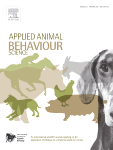Document type: scientific journal available online before publication in Frontiers in Animal Science
Authors: Melissa Davis, Paxton Sullivan, Jimena Breton, Lauren Dean, Lily N. Edwards-Callaway
Preview: The impact of pre-slaughter management practices on fed beef cattle welfare is a multifaceted and well researched subject matter. Factors such as transportation, handling, lairage time and several animal characteristics can directly impact the cattle's behavior, mobility, blood lactate and cortisol levels, likelihood of injury and ultimately overall cattle welfare. Therefore, the objectives of this scoping review were to (1) catalog pre-slaughter management factors that impact fed beef cattle welfare at the time of slaughter, (2) identify indicators used to evaluate the impact of pre-slaughter management on fed beef cattle welfare at slaughter, and (3) gain further understanding of the relationship between pre-slaughter management factors and fed beef cattle welfare outcome indicators at slaughter. A total of 69 studies were included in final analysis for this review, including studies from six geographic regions around the globe. Studies involving alternative slaughter methods (e.g., religious stunning or mobile slaughter) were not included in the formal analysis of this review, but still merited an in-depth discussion within this paper. After reviewing the studies, a total of 37 pre-slaughter factors and 69 indicators of welfare were measured throughout. Pre-slaughter management factors were then categorized by: animal characteristics; environmental characteristics; handling; lairage; transportation; and water/feed. Outcome indicators of welfare were categorized into: behaviors; health, injury and disease; physiological; and stunning and insensibility. Pre-slaughter factors relating to transportation and handling, and welfare outcomes measured by behaviors and physiology were of the most researched throughout the studies. The results of this review offer a catalog of commonly researched factors and indicators of welfare measured during the pre-slaughter phase, as well as the relationships between them. This review also offers further substantial evidence that a multitude of events in the pre-slaughter phase affect fed beef cattle welfare and a collection of highly applicable welfare indicators to expedite further research on the effects of pre-slaughter factors and the application of improved practices.






